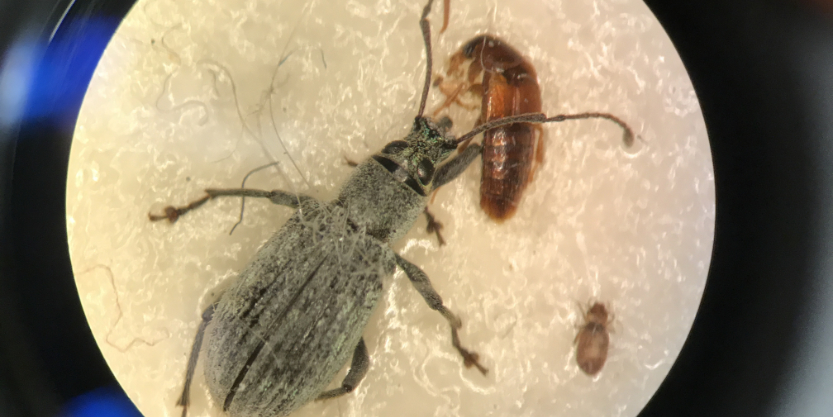Maria Bastidas-Spence of the Conserv Community Board has a background in Conservation and Marketing and holds a MA in Museums, Galleries and Contemporary Culture from the University of Westminster in the UK. Maria has experience in collection care working for museums in the United Kingdom and Colombia. For the past seven years, she has been working as a preventive conservator leader for national museum collections. Currently, she is the Preventive Conservator and the IPM Coordinator at Royal Museums Greenwich in the UK. Read on for answers on some of the most frequently asked questions regarding Integrated Pest Management for collections.
Contents
- What is Integrated Pest Management?
- Why is IPM important for collections?
- Why do we do IPM?
- Which collections are at risk of pest damage?
- Who is the best person to run an IPM program in a cultural institution?
- What is the best way to start an IPM program?
- What tools can I use to help me with my IPM program?
- Where can someone interested in IPM for cultural institutions get training or access to IPM resources?
- The Conserv IPM webinar series
- Future Conserv courses
What is Integrated Pest Management?
Integrated Pest Management or IPM is a concept drawn from the agricultural industry.
IPM was introduced to control pests using a more holistic approach rather than just using pesticides to eradicate pest infestations as this had devastating effects on ecosystems, the environment, and human health.
As a result, IPM focuses on achieving a more sustainable solution to control pest populations that involves an understanding of specific species and their habits.
Why is IPM important for collections?
The first pest infestation reported in a museum was found in the late 1970s in the UK, when David Pinniger, a well-respected entomologist in the field, assessed a hair loss problem with one of the natural history specimens. For decades now, IPM for museums has been a central program supporting Collection Care activities for cultural heritage institutions of all shapes and sizes, where prevention is one of the most important elements.
A major benefit of IPM in museums, libraries, archives, and historic houses is that it enables professionals to identify practical, safe, and cost-effective ways to prevent collections from suffering damage from pests.
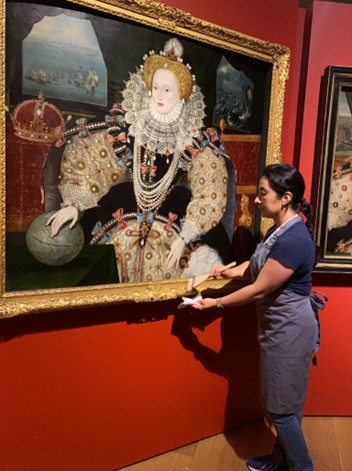
Preventive Conservator and IPM Coordinator for Royal Museums Greenwich, Maria Bastidas-Spence, discourages attacks from pests by planning gallery housekeeping to prevent pest infestations and cleaning objects on open display to prevent pest damage and other risks of deterioration for collections exhibited in galleries. Photograph by Maria Bastidas-Spence.
An Integrated Pest Management strategy includes the following steps or methods:
- Assess which pieces of our collection are most vulnerable to pest damage.
- Assess the spaces where these vulnerable collections are located.
- Identify which pests are present and which are most dangerous to those collections.
- Take actions to deny the pests access to the buildings and rooms by modifying the environment to discourage their attack.
- Continuously monitor, treat, and prevent pest problems.
- Share information with all employees and visitors on the importance of IPM and how to stop pests from living in our buildings.
By using this strategy, the pest problem is targeted with the right amount of resources, where appropriate preventive actions and pest treatments are used, and only where and when they are truly needed.
Among the organizations that compile the most up-to-date and comprehensive information on IPM for cultural institutions is MuseumPests.net, which is a product of the MuseumPests Working Group comprising collection managers, conservators, entomologists, and other professionals involved with IPM for cultural institutions.
To find out more about IPM and access its resources, you can go to their webpage, which lists all the information related to the major elements contained in IPM programs.
Why do we do IPM?
In collection care, pest damage is one of the risks we must mitigate so that heritage collections and museum artifacts may remain in peak condition to be handled, displayed, stored, studied, transported, and shared.
After an object has been in contact with a harmful insect, rodent or bird, it can show damage like bites, scratches, or stains, but in some extreme cases, an entire object or even a collection can disappear after an infestation of pests.
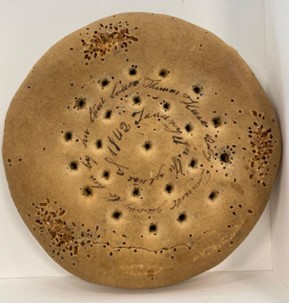
Photograph of a ship’s biscuit from the food collections at Royal Museums Greenwich showing damage caused by insects. Ship’s biscuits like this one were given to sailors as food rations in the 19th century during exploring voyages. After the voyage finished, the sailors took the biscuits as souvenirs. The irregular small holes with no pattern were made by insects called Stegobium Paniceum or commonly known as biscuit beetles in the UK. Object ID AAB0002. Photograph by Maria Bastidas-Spence.
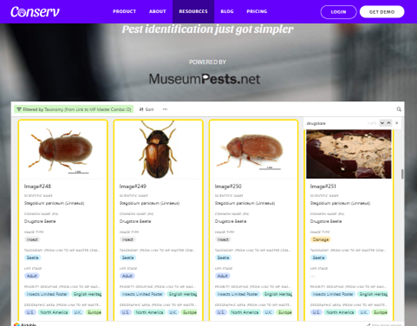
Screenshot of the Collections Pest Database powered by MuseumsPests.net, which is visible within Conserv’s software. The search shows images of Stegobium Paniceum commonly known as drugstore beetle or biscuit beetle.
Which collections are at risk of pest damage?
Many organisms, including insects, rodents, and birds, find shelter and food inside heritage buildings, which serve as habitats for them.
Heritage materials, such as textiles, fabrics, wood, and paper, contain proteins, cellulose, and starch, which provide them with energy for both living and reproducing.
Rodents and birds occasionally collect cardboard, paper, or vegetable fibers from collection items to make nests or homes.
Other insects can feed on mold or other dead insects. Rather than being a risk for collections specifically, they can be indicators of a further problem with the building envelope or housekeeping programs.
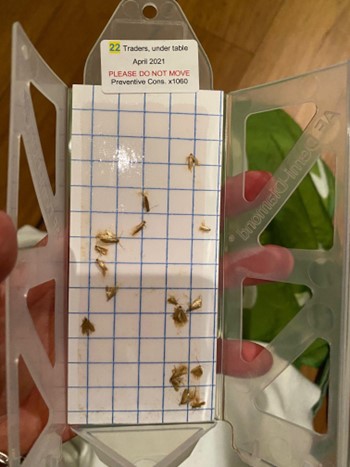
Pheromone lure monitor with dead adult Tineola bisselliella or webbing clothes moth. The larvae of this moth feed from protein-based materials like wool, silk, hair, fur or animal skins, feathers and horn. They can make small holes or even destroy entire objects. The monitor helps to catch this type of moth in exhibition or storage spaces to measure their activity. Replacing monitors at least every quarter helps to find trends over a period of time. Photograph by Maria Bastidas-Spence.
If the right environmental conditions are combined, exhibition and storage rooms can become an ideal space for pests to thrive. As a result, natural history and ethnographic materials are at the greatest risk of pest infestation. Similarly, textile and archival collections have items more likely to be damaged by pests.
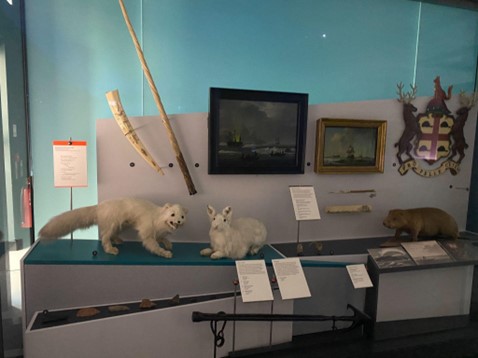
Display case at the Pacific Encounters gallery at the National Maritime Museum with natural collections specimens. Inside the display case and close to them, Maria places insect monitors to detect and record insect activity as a preventive tool. Photograph by Maria Bastidas-Spence.
Who is the best person to run an IPM programme in a cultural institution?
It is usually the responsibility of a Collections Care professional to coordinate an IPM program. However, in smaller institutions, staff in charge of collections, Estates staff, and volunteers could be trained and run successful IPM programs.
Ideally, a coordinator and a pest group should be established to share the workload of replacing monitors regularly (monthly, bi-monthly, or three-monthly), identifying insects, and processing and/or analyzing pest data.
What is the best way to start an IPM program?
To begin with, it is important to appoint an IPM coordinator and form a pest group (even if it is just one person). IPM programmes are most successful when they assess the pest population and determine the collection risk based on that population. Monitoring is the only way to do this. Starting with that is the best approach.
Monitoring insects is something that the IPM coordinator and the pest group can do routinely at least every three months. One way to monitor your insect population is to use insect trapping with sticky traps and pheromone lures. Some companies have developed monitoring tools for the heritage sector. If you are based in the USA and need to buy insect monitors you can find them at Insects Limited.
Monitoring rodents, birds, and other large vertebrates like bats, is usually left to external contractors since dealing with these pest populations can add some additional challenges related to human health and laws protecting certain species.
What tools can I use to help me with my IPM program?
Today, there are different tools for identifying, processing, and analyzing data. Conserv’s Integrated Pest Management tool makes use of the collections pest database powered by the experts and volunteers at MuseumPests.net. You can access the database directly through MuseumPests.net or from within Conserv’s free IPM software, and it is a relatively comprehensive list of insects and vertebrates that pose a risk to collections (it is continually being updated!). If you are looking for lures or insect monitors, Insects Limited is a well-established company with many years of experience in the collections and heritage sector.
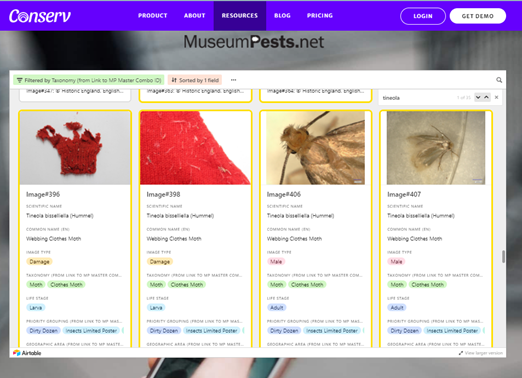
Screenshot of the collections pest database powered by MuseumsPests.net. The search shows Tineola Bisselliella or Webbing clothes moths. This is one of the most popular insects that are found in Museum collections and heritage buildings in the UK.
Where can someone interested in IPM for cultural institutions get training or access to IPM resources?
Some online resources are available, and some museums and institutions offer IPM courses. Make sure you check out the list of resources on IPM we have compiled for you. Many of them are free and accessible online.
Since Conserv is interested in improving collections management everywhere – regardless of the institution’s size, its number of staff, or its geographic location – we designed the IPM course and webinar series as a resource for anyone interested in getting started with IPM.
The Conserv IPM webinar series

Our webinar series includes insights from experts in the field who answered live questions. Watch the recordings today!
The Conserv IPM course and webinar series covers three basic topics:
- What is Integrated Pest Management?
- How monitor insect pests and identify insects in monitors
- How to analyze and report IPM data to stakeholders and colleagues
Our team of conservators and community board members designed the courses while thinking about small and middle-size institutions professionals.
The webinar series is intended to introduce the basics of IPM, and to have guest speakers who are well-known conservation professionals with considerable IPM experience in the field:
- Allison Lewis (Conserv) and Pat Kelley (Museumpests.net and Insects Limited)
- Rachael Arenstein (Museumpests.net and A.M. Art Conservation) and Matt Mickletz (MuseumPests.net and the Winterthur Museum Garden & Library)
- Christian Baars (National Museums Liverpool) and Jane Henderson (Cardiff University)
Future Conserv courses
If you enjoyed the IPM webinar series, make sure you visit our courses and webinars page and sign up for our newsletter to hear about future courses.
If you have any questions about environmental monitoring, integrated pest management, or just want to talk about preventative conservation, please reach out to us! Don’t forget to check out our blog or join our community of collections care professionals where you can discuss hot topics, connect with other conservators or even take a course to get familiar with the Conserv platform.

